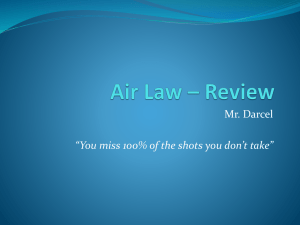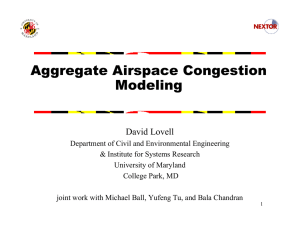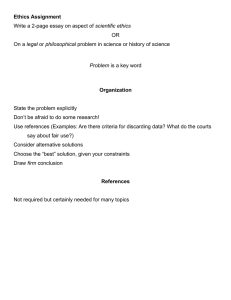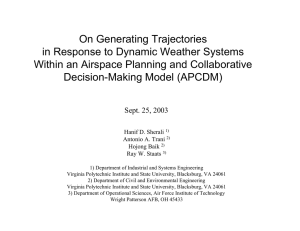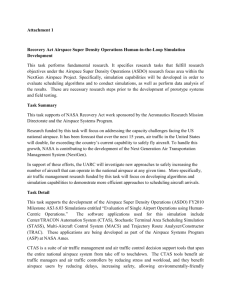V A M S
advertisement
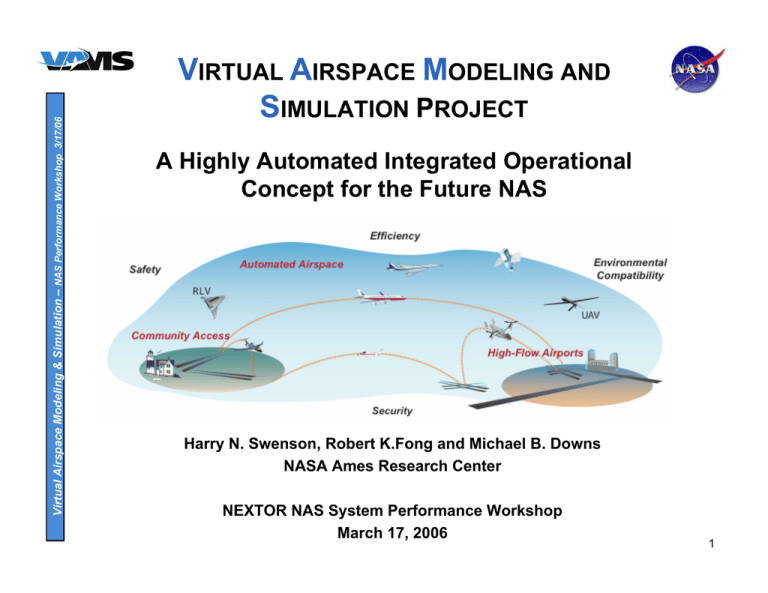
Virtual Airspace Modeling & Simulation – NAS Performance Workshop 3/17/06 VIRTUAL AIRSPACE MODELING AND SIMULATION PROJECT A Highly Automated Integrated Operational Concept for the Future NAS Harry N. Swenson, Robert K.Fong and Michael B. Downs NASA Ames Research Center NEXTOR NAS System Performance Workshop March 17, 2006 1 Virtual Airspace Modeling & Simulation – NAS Performance Workshop 3/17/06 Outline • • • • • • • Project Goals and Objectives Technical Approach Operational Concepts (examples) Evaluation Framework Blended Operational Concepts Airspace Concept Evaluation System (ACES) Example Results from Concept Analysis using ACES – Individual Concept Based – Blended System-Wide Concept • Summary 2 Virtual Airspace Modeling & Simulation – NAS Performance Workshop 3/17/06 Goal and Objectives The Goal of the VAMS Project is to identify and assess capabilities that lead to a significant increase in the capacity of the National Airspace System, while maintaining safety and affordability. The VAMS Objectives and Deliverables are: 1. To define and evaluate operational concepts 2. To generate enabling technology roadmaps 3. To establish the capability to assess these concepts 3 Technical Approach Improved Models Existing & New Models Run Time Data Collection Run Time Data Collection AER-based VAMS Aircraft VAMS Sub-Framework Sub-Framework Sim Run Control VAMS Framework (HLA RTI) Models Models Assessment System FACET Models Models Models Models Models OtherVAMS VAMS Other Other VAMS Sub-Framework Sub-Framework Sub-Framework Sim Run Control VAMS Other VAMS Other VAMS Sub-Framework Sub-Framework Sub-Framework Models Models Models Models Models Assessment System Models Models Models Models Models Models Virtual Airspace Modeling & Simulation – NAS Performance Workshop 3/17/06 Set of Operational Concepts VAMS Framework (HLA RTI) Develop New Concepts Develop, Test & Verify Integrated System-Wide Simulation Capability Validated Simulation System Benchmark Deliverable Baseline Deliverable Deliverable Efficiency • Concept Assessment • Scenario Requirements • Evaluation Metrics Safety Automated Airspace Environmen Compatibili RLV UAV Community Access Scenarios & Metrics High-Flow Airports Security Evaluated & Assessed Revolutionary Operational Concepts Technology Roadmaps 4 Operational Concepts Virtual Airspace Modeling & Simulation – NAS Performance Workshop 3/17/06 System-level Cruise descent climb NASA ARC - Advanced Airspace Boeing - ATM Concept Metron - Weather Seagull - Massive PTP NASA ARC - SystemSystem-wide Optimization FAA/RTCA - Future ATM Concept University Planning Team Transition takeoff landing NASA LaRC - Wake Avoidance Raytheon - Terminal Area Concept taxi taxi Surface taxi gate Metron - Surface Traffic Automation Optimal Synthesis - Surface Operation Automation gate 5 Virtual Airspace Modeling & Simulation – NAS Performance Workshop 3/17/06 Advanced Airspace Concept System Architecture Equipped Equipped Equipped Unequipped Data Link Automated Trajectory Server; Conflict Resolution (>1 min. to separation violation) Controller Interface Voice Link Tactical Separation Assurance: TSAFE (<1 min. to separation violation) Assigned 4D Trajectories for all Aircraft in Sector Heinz Erzberger, NASA ARC 6 Virtual Airspace Modeling & Simulation – NAS Performance Workshop 3/17/06 Multiple Conflicts in High Density Airspace • Must resolve “secondary” conflicts (two kinds) – Conflicts that occur shortly after the first (primary) conflict – New conflicts that arise in a candidate trial resolution New 2ndary conflict resulting from resolution maneuver 2ndary conflict Primary conflict Resolution trajectory resolves initial and 2ndary conflicts Primary conflict Resolution trajectory avoids new 2ndary conflicts Heinz Erzberger, NASA ARC 7 Virtual Airspace Modeling & Simulation – NAS Performance Workshop 3/17/06 Concept PTP: Massive Point-to-Point and On-Demand Air Transportation - Sensis Technologies Point-to-Point Concept Facilitates Efficient Use of: En Route Self-separating aircraft in high altitude airspace with 4D FMS-ATM trajectory negotiation in lower altitudes New Aircraft Types Terminal 4D approach and departure trajectory contracts to/from dense hubs and local small airports More Destinations Result: Potential Order of Magnitude Increase in NAS Capacity Surface Non-towered airport ATM automation and precision landing guidance Cross-cutting TFM Seagull Technology Team PTP High-fidelity trajectory-based flight planning and replanning coordination between aircraft operator and ATSP from pre-flight to gate-in 8 Virtual Airspace Modeling & Simulation – NAS Performance Workshop 3/17/06 Framework for Scenario & Metrics Development Stakeholder Viewpoints (questions to be answered) concepts operational scenarios Stakeholder Viewpoints (questions to be answered) NAS Model 1. Scope: • issues • NAS Domain • challenges • assumptions 2. Top Level Descriptions: • core ideas • functions 3. Detailed Descriptions: • performance • roles, responsibilities of humans & machine • human factors • user interfaces 4. NAS infrastructure & technology impacts: • transition planning • architecture • technology requirements Scenario Elements: • NAS Domain • NAS Perturbations (e.g. Wx, Security Incidents) • Origin/Destination Demand • Assumed Technologies • Human/Machine Performance • Defined ATM Procedures • Assumed Equipage • Fleet Mix • Etc. Simulations output metrics • Number of traffic events (takeoffs, sector crossings, landings, etc.) • Number of communication events (requests, clearances, directives, etc.) • Throughput (traffic volume) • Delay • Safety incidents (proximity to minimum separation, incursions, encroachments, etc.) • Elapsed flight times • Fuel burn • Capital investments • Personnel workloads • Etc. evaluation metrics •Average aircraft flight time per air route •Average aircraft payload per flight mile •Operational cost per passenger mile •Average taxi time from pushback to wheels up during peak traffic periods per specific airports or taxi paths within airports •Average voice channel occupancy time per departure from pushback to take off •Average Airport arrival rate during peak periods •Rate of arrivals per controller hour per airport •Aircraft (or engine, or other component) maintenance costs per flight mile •Etc. * a defined city pair air route Empiric Analysis 9 Virtual Airspace Modeling & Simulation – NAS Performance Workshop 3/17/06 Performance Measures and Metrics Capacity • Total Flights Flown • Total commercial flights per day • Total passenger trips • Total Passenger revenue miles for metro pairs • Average airport arrival rates • Average airport departure rates • Average block time • Passenger arrivals / departures per hour • Distance per OD • Comparison of average number of flights to average delay • Total System Delays by category • Available seat miles • Time required for surface movement per flight • Ratio of VMC to IMC capacity • Comparison of AAR and ADR with peak throughput Throughput • Airport IMC and VMC throughput compared with Airport IMC and VMC throughput Index (AITI, AVTI) • Peak airport Throughput • Peak Sector or Center throughput • Peak En route Throughput Efficiency • Total aircraft travel time for (constant demand) • Total aircraft miles flown • Average Flight time per origin/destination pair • Fuel burn index • Average of aircraft over an arrival fix per hour during peak periods • Surface traffic efficiency • Average number of gate arrival and departure times Predictability • Number of flights more than 15 minutes late • Average and standard Deviation of the difference between actual and planned flight time • Number of passengers more than 15 minutes late arriving • Average departure delay • Average number of minutes late per flight Human Factors • Average number of aircraft controlled per controller position • Estimated workload of controllers Safety • Point of closest approach 10 Concepts Surface (ATCT) Terminal (TRACON) En Route (ARTCC) National (ATCSSC/AOC) 1 AAC 2 SWO 3 WVAS 4 PTP 5 All Weather 6 TACEC 7 SOAR 8 Universities 9 OEP v5+ System-Wide Concepts Resolve Overlaps and Gaps Across Domains (e.g., Aircraft Systems) Synthesized System-Wide Operating Concept Virtual Airspace Modeling & Simulation – NAS Performance Workshop 3/17/06 VAMS System-Wide Concept Blending 11 Virtual Airspace Modeling & Simulation – NAS Performance Workshop 3/17/06 Improved Predictability through Intent-based Strategic Planning 12 Virtual Airspace Modeling & Simulation – NAS Performance Workshop 3/17/06 Increased Airborne Throughput Utilizing Automated Separation Assurance 13 Virtual Airspace Modeling & Simulation – NAS Performance Workshop 3/17/06 Increased Capacity through Dynamic Traffic Management Techniques 14 Virtual Airspace Modeling & Simulation – NAS Performance Workshop 3/17/06 Reduced Aircraft Separation in All-Weather Conditions thru Advanced Ground and Air Technologies 15 Virtual Airspace Modeling & Simulation – NAS Performance Workshop 3/17/06 Allocation of Tasks between Human and Automation Humans: • Direction and Management of Automation • Decisionmaking Handling of Unequipped Aircraft • Strategic Direction of Response to Anomalous Conditions Automation: • Creation, validation, Clearance Delivery, and Conformance Monitoring of 4D Trajectories • Tactical Handling of Anomalous Conditions • Automated Failure Backup 16 Virtual Airspace Modeling & Simulation – NAS Performance Workshop 3/17/06 The Airspace Concept Evaluation System (ACES) Modeling Toolbox National Traffic Management Regional Traffic Management Fast-time, nationwide gate-to-gate Thousands of participating agents: simulation of ATM-FD-AOC • National 1 • Regional 20 operations • Local 100s • Full flight schedule with flight • Airports 100s plans, 4-D gridded winds, gate-to• Aircraft 10,000s • Airlines 10s gate operations Local Approach and Departure Traffic Management Airport and Surface Traffic Management High Fidelity 4-DOF Trajectory Model • Based on laws of physics and aerodynamics • Realistic pilot-based control laws • Includes elliptic-Earth trajectory propagation • Contains modeling for aircraft/pilot variability 17 41 min. 3000 TFM delays due to flow restrictions in current system. Delays due to auto resolutions; TFM flow restrictions not required. 20 11 7 2000 1700 conflicts resolved 12.6 10 2500 conflicts resolved Impractical TFM solutions 12 1000 # of conflicts resolved per day 30 Delay/flight, in seconds Virtual Airspace Modeling & Simulation – NAS Performance Workshop 3/17/06 Performance Comparison of Current System and AAC (Simulation of Cleveland Center Airspace) 500 conflicts resolved 1x; 6000 flights May 17, 2002 2x; 12000 flights May 17, 2002 3x; 18000 flights Feb. 14, 2004 18 0 la n Bo ta s C C h ton hi c a arl o g o tte M e C in tro ci D C l n na al ev ti la s / el a Ft n .W d or D th en ve D r et H ro i ou t s LA ton La Ba M s si n ia Ve m i/F M ga t . em s La p M ud his in e N n. rd a ew /S le Yo t. P rk a u M l e O tr Ph rla o i la n d de o lp Ph hia P i o en t ts i x bu P o P o rgh t o rt l m a Sa a c nd A lt La re k a Sa e C Sa n it D y n Fr ieg an o cis c Se o St a ttle .L ou Ta is m pa At Factor Virtual Airspace Modeling & Simulation – NAS Performance Workshop 3/17/06 NAS-wide Benefit Results • Using Diversion of 34 CONUS OEP Apt Demand to PTP Auxiliary Apts PTP IncreaseRe gion = 14 12 ∑ All Airport CapacityRe gion ∑ OEP Airport CapacityRe gion PT P Airport Operations Analysis VMC PTP Increase to Region IMC PTP Increase to Region 10 8 6 4 2 19 4.5 4 3.5 Normalized, Current Day Baseline Virtual Airspace Modeling & Simulation – NAS Performance Workshop 3/17/06 Example Results – Flights, RPM, and Trips 3 Current day, No WX OEP v5, No Wx Future H&S, No WX Future H&S+PTP, No WX Current day, WX OEP v5, Wx Future H&S, WX Future H&S+PTP, WX 2.5 2 1.5 1 0.5 0 No Wx WX Flights No WX WX RPM No WX WX Passenger Trips No WX WX Avg Fuel Efficiency (gal/hr) No WX WX Avg Total Delay 20 Virtual Airspace Modeling & Simulation – NAS Performance Workshop 3/17/06 Summary • VAMS has developed and analyzed a wide range of innovative operational concepts that provide significant increases in capacity for the National Airspace System (NAS). • VAMS has created a non-real time, system-wide analytical simulation and modeling tool set that has explored domain specific and systemic performance characteristics of the VAMS innovative concepts. • VAMS has developed and applied an blending and synthesis process for the integration of Operational Concept Elements into a capacity increasing System-Wide Operational Concept. • VAMS is currently documenting the System-Wide Operational concept along with the synthesis and analysis process including research issues encountered. (Just entered peer review.) 21 Virtual Airspace Modeling & Simulation – NAS Performance Workshop 3/17/06 Backup Slides 22 Virtual Airspace Modeling & Simulation – NAS Performance Workshop 3/17/06 PSCA - ACES Experimental Conditions – ACES Build 4.0.2_NASA – Weather days • Perfect – all facilities in VFR • Nominal – actual 5/17/02 weather – – – – – – – – – – – Sector capacities – See Below Airport capacities – See Below CD&R – Off Delay Maneuvers – Off Arrival Fix Spacing – Off Arrival Fix TRACON Delay – Off Departure Fix TRACON Delay – Off AOC Operation – Off Tail Tracking – Off Airport mode – Nodal En-route weather modeling 23 Virtual Airspace Modeling & Simulation – NAS Performance Workshop 3/17/06 PSCA - Trial Matrix System Demand Current Day OEP 2015 Future H/S (+50%) OEP 2015 X # VAMS SWC # X Current Day Future H/S (+100%) Future H/S + PTP (+100%) # # # X X X Future H/S +PTP (+50%) X Legend: Black - Need to run Red - Run if 50% is good # - they are needed for a direct comparison, considered optional for now Other Notes: • Current x Current run could be used to characterize/establish acceptable delay • OEP2015 x OEP2015 could also be used to characterize/establish acceptable delay • Need to run matrix for all Wx days chosen (perfect and nominal) • Is OEP 2015 is approximately 1.5X? • First runs performed would be 1) future H/S+PTP (50%) X VAMS System-wide Concept, perfect weather 24 Virtual Airspace Modeling & Simulation – NAS Performance Workshop 3/17/06 PSCA - Operating Conditions A. B. C. D. E. F. Benchmark 2004 Report: Current Day Airport Operating Capacities FAA Advisory Circular 150/5060-5 Airport Capacity and Delay ASPM Airport Operating Capacities Adaptation Controlled Environment System (ACES) Koenke and Abramson White Paper (Aug 2005) VAMS Blended Concept Descriptions Run Demand Capacity Definition (see legend above) Condition Current Day No Weather Current Day A,B,C,D VFR Current Day Moderate Weather Current Day A,B,C,D VFR/IFR OEP No Weather OEP 2015 A,B,C,D,E VFR OEP Moderate Weather OEP 2015 A,B,C,D,E VFR/IFR Future 1.5x No Weather Future 2020 A,B,C,D,E VFR Future 1.5x Moderate Weather Future 2020 A,B,C,D,E,F VFR/IFR Future PTP 1.5x No Weather Future 2020 A,B,C,D,E,F VFR Future PTP 1.5x Moderate Weather Future 2020 A,B,C,D,E,F VFR/IFR Implementation VFR at all airports Airport State Files Sector MAP Scenario File VFR at all airports Airport State Files Sector MAP Scenario VFR at all airports Airport State Files Sector MAP Scenario VFR at all airports Airport State Files Sector MAP Scenario 25 Virtual Airspace Modeling & Simulation – NAS Performance Workshop 3/17/06 PSCA Results, Flights and BMK Ops Scenario Description Metric Current Day No Wx Wx OEP Future 1.5 No Wx Wx No Wx Wx PTP 1.5 No Wx Wx Flights in NAS 43016 41927 56004 54102 67341 64903 69744 67651 Domestic flights 40394 39319 52543 50679 63047 60656 65441 63359 International flights 2622 2608 3461 3423 4294 4247 4303 4292 Operations at Benchmark airport 28919 28044 38758 37233 47728 45780 47174 45602 % operations at benchmark 67.2% 66.8% 69.2% 68.8% 70.8% 70.5% 67.6% 67.4% 26 Virtual Airspace Modeling & Simulation – NAS Performance Workshop 3/17/06 PSCA – Traffic Mix 45000 Commercial Air Taxi General Aviation Freight Military Other 40000 35000 30000 25000 20000 15000 10000 5000 0 no Wx with Wx Current Day no Wx with Wx OEP no Wx with Wx Future 1.5 no Wx with Wx PTP 1.5 27 Virtual Airspace Modeling & Simulation – NAS Performance Workshop 3/17/06 Example Results – Flights, RPM, and Trips 2 1.8 Current day, No WX Future H&S, No WX Current day, WX Future H&S, WX OEP v5, No Wx Future H&S+PTP, No WX OEP v5, Wx Future H&S+PTP, WX 1.6 1.4 1.2 1 0.8 0.6 0.4 0.2 0 Load Seats Flights Distance RPM Passenger Trips 28 Virtual Airspace Modeling & Simulation – NAS Performance Workshop 3/17/06 Major Air Transportation System Performance Dimensions Scaled 29 Virtual Airspace Modeling & Simulation – NAS Performance Workshop 3/17/06 Human Performance Evaluation Capability • Provide for high-fidelity evaluation of human performance and/or roles and responsibilities issues of new operational concepts • Integrate models, simulation labs and facilities into a distributed network • Leverage existing facilities and models • Reconfigurable to meet different concept requirements 30 Virtual Airspace Modeling & Simulation – NAS Performance Workshop 3/17/06 Facility Integration Innovations • Facility Integration Tools – Bridges - connect components with different implementations of an HLA communications protocol to VAST-RT – Portals - connect components with non-HLA communications protocols to VAST-RT – Ownership Handoff Manager - allows control of an aircraft to pass to different facilities as the aircraft moves through space • Distributed Simulation Tools – Data collection – Centralized simulation clock – A generic component to supply data unavailable from some facilities, but needed by other components or facilities • Other Research Tools – Displays and Decision Support Tools to support AOC participation – Interfaces to non-ATM research tools – Displays for simulation monitoring and observer participation 31 Virtual Airspace Modeling & Simulation – NAS Performance Workshop 3/17/06 Human Performance Evaluation Capability September 2005 B747 Level D Simulator HLA Comm Toolbox Advanced Concepts Flight Simulator HLA Comm Toolbox Vertical Motion Simulator HLA Comm Toolbox DST GoSAFE Surface Automation Tool DST FutureFlight Central HLA Bridge ADRS Portal Toolbox Surface Management System (SMS) CVSRF ATC Lab HLA Comm Toolbox Airspace Operations Laboratory UAV Simulator Toolbox Toolbox HLA Comm Toolbox Airspace Traffic Generator 32 Virtual Airspace Modeling & Simulation – NAS Performance Workshop 3/17/06 Model Interactions within ACES Cruise En Route Descend Climb Terminal Takeoff Landing Taxi Taxi Surface Gate Controller Dispatch Controller Dispatch Gate 33 Virtual Airspace Modeling & Simulation – NAS Performance Workshop 3/17/06 ACES Simulation of AAC Automated Resolution • Includes realistic models of aircraft performance, guidance functions and 4D trajectories • Monte Carlo like simulation environment Each 24 hour long ACES run includes thousands of conflict encounters Provides unbiased and statistically significant results • Results for Cleveland Center Traffic – Investigated range of traffic densities and res. parameters 1X, 2X, 3X traffic density Time to first loss range for generating resolutions: 1-8 minutes Conflict free range for resolutions: 12 minutes All types of conflicts, including arrival vs. arrival Airspace and traffic above 10,000 ft – Dominant conflicts 60 % non cruise or mixed cruise non- cruise – Resolution strategy Comparison of performance for vertical and horizontal resolution priority 34 Virtual Airspace Modeling & Simulation – NAS Performance Workshop 3/17/06 ACES Atlanta Security Event Analysis 35 Flights Boeing Forecast 1.4-3X 3X Biz shift ~3X • 2% shift to micro jets Note: Not to scale 2.4X Enplanement Demand Virtual Airspace Modeling & Simulation – NAS Performance Workshop 3/17/06 JPDO* Future Demand Projections F TA ~2X Biz shift • Smaller aircraft, more airports rm Te re lA a in as c e or aF F) A T t( ow r G t ow r G FG TA th s tio a R r hP row oje ig ,H on cti he e at R r Passengers 1.8-2.4X ate rR e w , Lo s o i at th R Increase of over 10 passengers per flight Shift in passengers per flight (e.g., A380, reverse RJ trend, higher load factor) 2014 and later Baseline analysis will use OEP & FACT Capacities 1X 2004 2014 2025 20?? Time * JPDO Evaluation and Analysis Division 36
